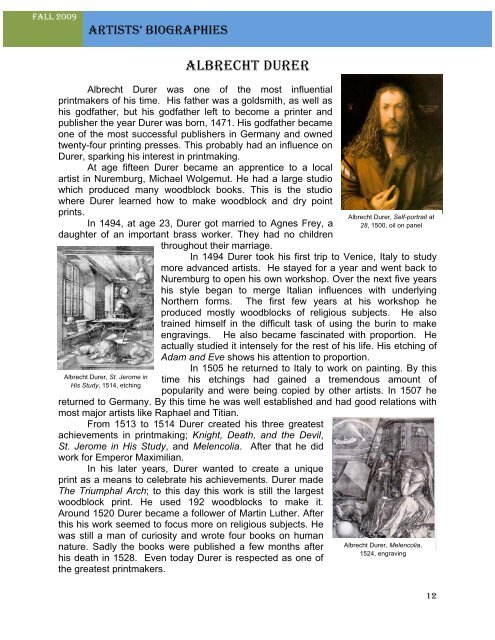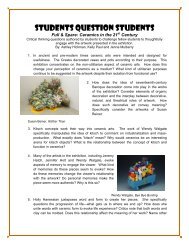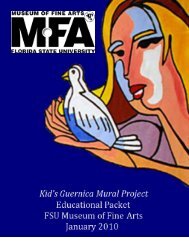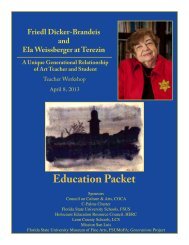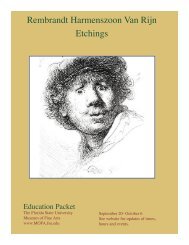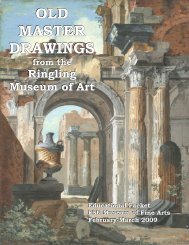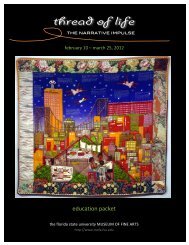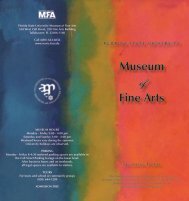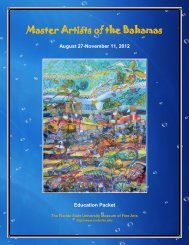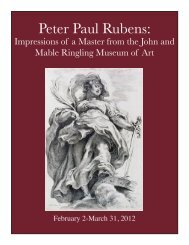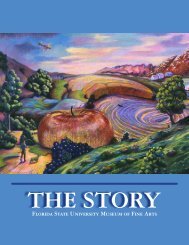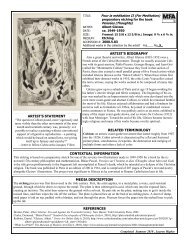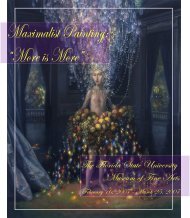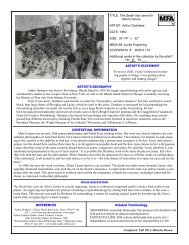Matrix: Contemporary Printmaking - Museum of Fine Arts - Florida ...
Matrix: Contemporary Printmaking - Museum of Fine Arts - Florida ...
Matrix: Contemporary Printmaking - Museum of Fine Arts - Florida ...
You also want an ePaper? Increase the reach of your titles
YUMPU automatically turns print PDFs into web optimized ePapers that Google loves.
Fall 2009<br />
Artists’ Biographies<br />
Albrecht Durer, St. Jerome in<br />
His Study, 1514, etching<br />
Albrecht Durer<br />
Albrecht Durer was one <strong>of</strong> the most influential<br />
printmakers <strong>of</strong> his time. His father was a goldsmith, as well as<br />
his godfather, but his godfather left to become a printer and<br />
publisher the year Durer was born, 1471. His godfather became<br />
one <strong>of</strong> the most successful publishers in Germany and owned<br />
twenty-four printing presses. This probably had an influence on<br />
Durer, sparking his interest in printmaking.<br />
At age fifteen Durer became an apprentice to a local<br />
artist in Nuremburg, Michael Wolgemut. He had a large studio<br />
which produced many woodblock books. This is the studio<br />
where Durer learned how to make woodblock and dry point<br />
prints.<br />
In 1494, at age 23, Durer got married to Agnes Frey, a<br />
daughter <strong>of</strong> an important brass worker. They had no children<br />
throughout their marriage.<br />
Albrecht Durer, Self-portrait at<br />
28, 1500, oil on panel<br />
In 1494 Durer took his first trip to Venice, Italy to study<br />
more advanced artists. He stayed for a year and went back to<br />
Nuremburg to open his own workshop. Over the next five years<br />
his style began to merge Italian influences with underlying<br />
Northern forms. The first few years at his workshop he<br />
produced mostly woodblocks <strong>of</strong> religious subjects. He also<br />
trained himself in the difficult task <strong>of</strong> using the burin to make<br />
engravings. He also became fascinated with proportion. He<br />
actually studied it intensely for the rest <strong>of</strong> his life. His etching <strong>of</strong><br />
Adam and Eve shows his attention to proportion.<br />
In 1505 he returned to Italy to work on painting. By this<br />
time his etchings had gained a tremendous amount <strong>of</strong><br />
popularity and were being copied by other artists. In 1507 he<br />
returned to Germany. By this time he was well established and had good relations with<br />
most major artists like Raphael and Titian.<br />
From 1513 to 1514 Durer created his three greatest<br />
achievements in printmaking; Knight, Death, and the Devil,<br />
St. Jerome in His Study, and Melencolia. After that he did<br />
work for Emperor Maximilian.<br />
In his later years, Durer wanted to create a unique<br />
print as a means to celebrate his achievements. Durer made<br />
The Triumphal Arch; to this day this work is still the largest<br />
woodblock print. He used 192 woodblocks to make it.<br />
Around 1520 Durer became a follower <strong>of</strong> Martin Luther. After<br />
this his work seemed to focus more on religious subjects. He<br />
was still a man <strong>of</strong> curiosity and wrote four books on human<br />
nature. Sadly the books were published a few months after<br />
his death in 1528. Even today Durer is respected as one <strong>of</strong><br />
the greatest printmakers.<br />
Albrecht Durer, Melencolia,<br />
1524, engraving<br />
12


